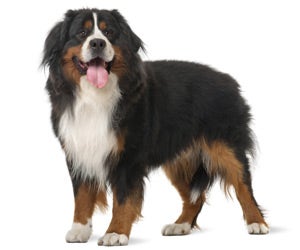Bernese Mountain Dog
-
Overview
The Bernese Mountain Dog's attractive coat and calm, gentle personality make them a stunning pet. They love the company of people, including children, and they hate being separated from their families for too long. Bernese Mountain Dogs make devoted companions for those with the energy to exercise a large, energetic dog and the willingness to maintain their luxurious but long, dense coats.
-
Personality
-
Coat Care

Although Bernese Mountain Dogs do not need to be trimmed or clipped often, their shiny coats require frequent bathing and lots of brushing to retain their natural sheen. This huge dog will shed throughout the year, but he will shed profusely during the spring and fall. To help manage the amount of hair he loses during this time, brush your Bernese Mountain Dog throughout the year.
Although Bernese Mountain Dogs do not need to be trimmed or clipped often, their shiny coats require frequent bathing and lots of brushing to retain their natural sheen. Bathing your dog will help his coat retain his shine and hold its deep colors, so bath him occasionally with detangling dog shampoo.
Clipping or trimming your dog’s coat is far easier than you would ever imagine. With the right clipper, trimmer and scissors, giving your dog a haircut is easy on your wallet and your schedule.
Dogs with heavy coats generally require routine trimming around the face, ears, feet and behind to help them stay comfortable. You do not need to clip or trim the body hair because it acts as insulation for your dog in cold weather and helps cool him off in warm weather. It’s a good idea to take your dog for a short walk to calm him down before you groom him. Thoroughly brush the coat to remove any tangles and mats. Use trimmers to trim excess fur off the dog's body, choosing the appropriate clip attachment to achieve desired length. Trim around the tail, paws, sanitary areas and chest, if needed. Groom the head and face last, being watchful for sudden movement. Trim with the flow of the fur, away from the eyes and nose.
Many dog owners are apprehensive about trimming their dog’s nails because they are nervous about cutting into the quick. But with the right conditioning and careful cutting, nail clipping can be a simple, stress-free activity for you and your dog.
Provide your dog with plenty of positive reinforcement and even treats to help associate nail clipping with a positive experience. As you start to clip, gently press on your dog’s paws to help him become accustomed to the feeling of having his nails clipped. Then, work gradually, shaving down just a thin portion of the nail at first to make sure you don’t reach the quick. Clip one nail, reward your dog with a treat, and stop to give him some positive reinforcement before moving on. Gradually increase the number of nails you clip in one sitting to help your dog get used to the process. Never trim extremely long nails down to a short nail in one sitting, because this is an excellent way to accidently quick the dog’s nail. Instead, work gradually, shaving small portions of your dog’s nails off each time.
You can tell if you’re getting close to the quick by the texture of your dog’s nail. The nail is hard closer to the surface and becomes softer as you get closer to the quick. If your dog’s nail starts to feel softer, that’s a good indication that you’re getting close to the quick.
Not all breeds and coat styles require routine trimming in and around the eyes and ears but all should undergo regular inspection and cleaning around these sensitive areas. Doing so will help prevent the development of infections that could seriously damage these amazing organs.
It is always important to routinely clean your dog's eyes and ears, and examine for potential infections. Small dogs, like Pomeranians, and dogs with extremely profuse coats, like Newfoundlands, American Eskimo Dogs and Keeshonds, have ears that need to be checked weekly for infection and cleaned with a cotton ball. Gently wipe a cotton ball moistened with mineral oil, olive oil or witch hazel in your dog's ear, being careful to avoid the ear canal. Never use a Q-Tip, which could cause damage to the inner ear if your dog suddenly shakes or jerks his head. Bushy hair growth within the ear can be thinned with tweezers or blunt scissors. Use a small trimmer to trim excess hair around the eyes, ears and face. Small dogs like Pomeranians and Pekingese, and dogs with white coats like American Eskimo Dogs and Samoyeds, are prone to developing tear stains around their eyes, so clean around their eyes with a cotton ball or soft cloth and use a small trimmer to trim excess hair around their eyes.
Bernese Mountain Dogs are unfortunately prone to bad breath. Brushing their teeth once a week will help their breath stay fresh and their teeth stay healthy.

 India (English)
India (English)
 Middle East and Africa (English)
Middle East and Africa (English)
 South Africa (English)
South Africa (English)
 Australia (English)
Australia (English)
 Japan (日本語)
Japan (日本語)
 South East Asia (English)
South East Asia (English)
 Singapore (English)
Singapore (English)
 Europe (English)
Europe (English)
 United Kingdom (English)
United Kingdom (English)
 Argentina (Español)
Argentina (Español)
 Brazil (Portuguese)
Brazil (Portuguese)
 Colombia (Español)
Colombia (Español)
 Latin America (Español)
Latin America (Español)
 México (Español)
México (Español)
 Chile (Español)
Chile (Español)
 Peru (Español)
Peru (Español)
 Canada (English)
Canada (English)

